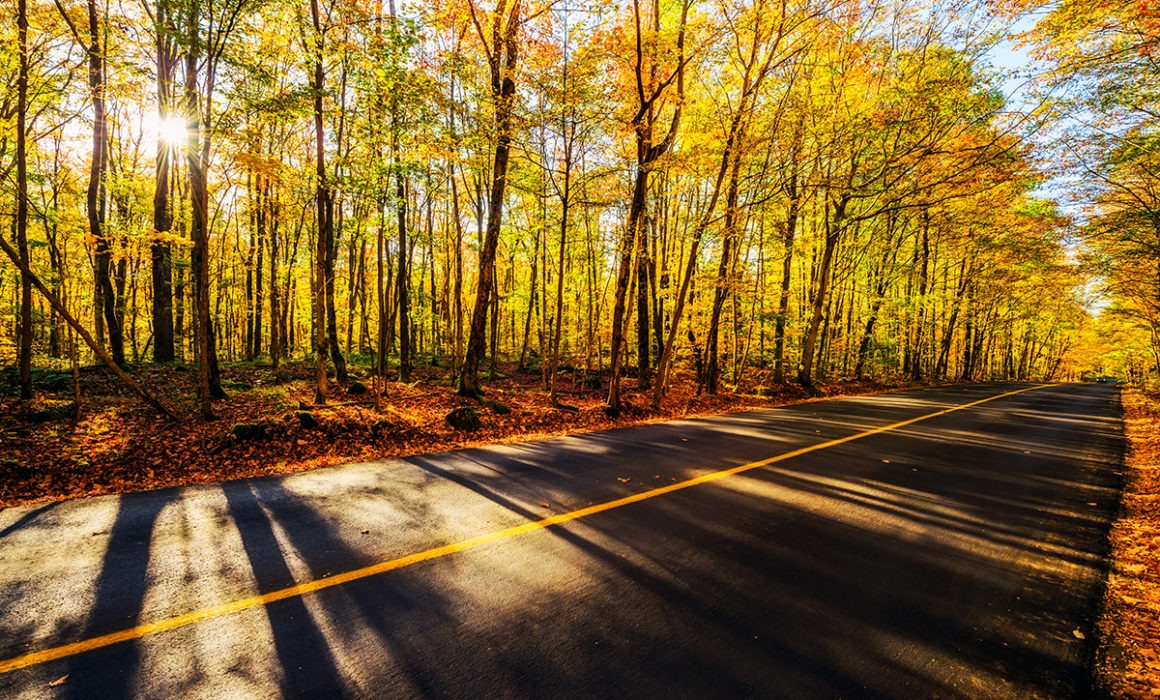Cool Roads for Cool Fall Driving
There are three types of roads in Muskoka: through roads, get-to roads, and, for drivers, really cool roads.
Through roads (Highway 11, Highway 169) are four lanes, free flowing, and boring. They cut hard swaths through rock and wood. They move loads of cars. They transport Muskokans from points A to B. And, while necessary, they’re also uninspiring.
Get-to roads (Highway 118, Highway 117) are the two-laners used to reach our homes and cottages. They lay more interesting tracks—past lakes and swamps, wood, rock, the occasional dwelling—and their hillsides in fall are peppered with coloured maples: red, yellow, rusty brown, and orange.
Muskoka’s really cool roads are those few people use, or are even aware of. They ripple by unknown lakes, rumble through vast outcroppings of rock, roll over hills and past ghost towns long since forgotten. These roads are for drivers. These roads are worthy of an autumn afternoon in an enviable car with a killer sound system.
There are many, many cool roads in Muskoka. These three suggestions surround Lake of Bays, travelling from Bracebridge to Baysville, to Dorset, Dwight, and Huntsville.
- On the outskirts of Bracebridge, head north on Cedar Lane—a cool road. It starts out broad and bland. But once past Macaulay Public School, it narrows and gets interesting. With its sweeping bends and the occasional hard corner, this tight two-laner segues swiftly into Highway 117. Yes, the fun is over too quickly. Soon you’ll find yourself on a get-to road that leads direct to Lake of Bays.
- Past Bayville, head northeast on 117. For drivers, this section of get-to road is uninspiring until you reach a real classic, Old Highway 117—another cool road. Watch carefully for the left turn off new 117 to the old portion—the signs will also point the way to Norway Point. Soon after the turn, take a side trip on Glenmount Road, which leads to the Point, so called because of the collection of Norway pines on its shore. There’s a whitewashed church close by, hidden in a grove of old trees and surrounded by some of the lake’s oldest cottages. The lakeside church, built in 1944, replaces the original built in 1908 by the ministers of the day. That building collapsed under the weight of the snow. As Mary Lynn Findlay says in her book Lures and Legends of Lake of Bays, “the ministers were better preachers than they were builders.”
Doubling back on Glenmount Road to Old Highway 117, hang a left and steer for the mainland docks of Bigwin Island. For drivers, this section is classic old-cottage-road fare. It’s a sleepy little track that follows the contours of the land—the road bends to nature rather than nature being blasted away to make way for the road. There are gentle elevation changes, pretty views of the lake, and a glimpses of cottage life on Lake of Bays. It’s short but sweet, delivering you back to new 117 in about 15 minutes.
- South Portage Road from Dwight Beach Road to North Portage is a series of twists and turns through tunnels of trees. These swoops and dips are a tempting lead-in to the thrills that lie ahead on North Portage. As you approach North Portage you’ll pass by a public beach and boat launch area. Turn right onto North Portage and you immediately climb a hill and start to twist and turn through heavily wooded tracts of land. The turns come quickly, and must be respected as traffic can be steady on this section of cool road. Some corners require firm braking and lots of steering input, but they’re well signed and include suggested speeds. About one-third of the way along North Portage is the white-washed Portage Inn. Don’t gawk, as the road takes a sharp left and begins to parallel the south shore of Peninsula Lake. This roller-coaster ride is wonderful fun, if a little rough. The road surface has suffered from the freeze-thaw cycle, and some sections have weathered more poorly than others. As you twist and turn along North Portage you’ll come to one final sharp right-hand corner and you pop out onto Canal Road, and from there you’ll head on to Huntsville.


